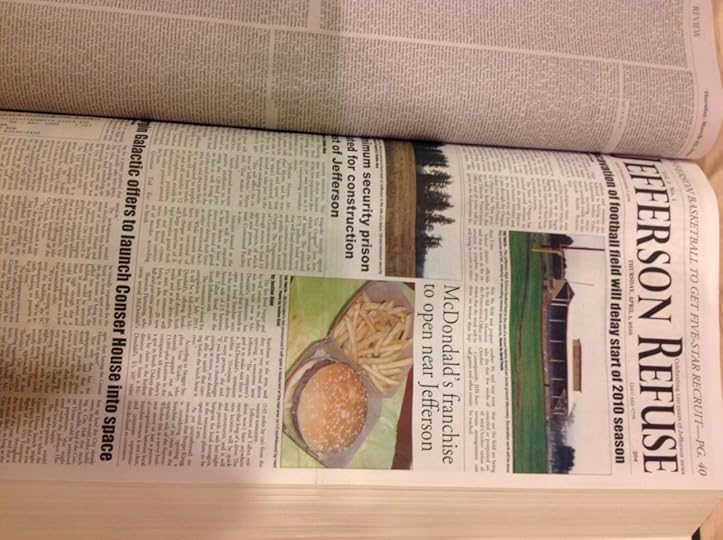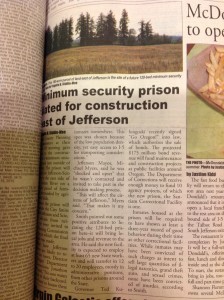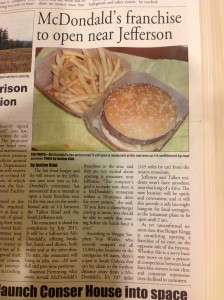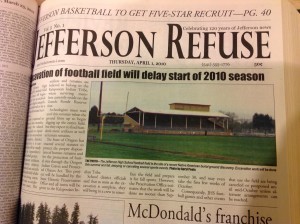G.A. Albrethsen's Blog: Age of Restoration
October 31, 2015
April Fools’ Day Articles In 10 Easy Steps

From 1998-2012, I owned one or more weekly newspapers. As publisher, my number one goal was to provide the communities we served with fair, accurate news. We provided readers with the pertinent details so they could draw their own conclusions, while leaving the opinions on the editorial page where they belonged.
In other words, we spent most of our time building trust and credibility. Readers didn’t always like what we wrote, but they almost always respected the fact that we provided them with unbiased, factual information.
Despite all of that, twice during that fifteen year span, we gleefully put our reputations on the line and purposefully deceived our readers. Instead of steadfastly adhering to the principles of journalism, we threw them out the window.
Why? April Fools’ Day.
Ironically, some of our highest sales came from those editions. Not only that, feedback was higher than for our normal issues and it was more favorable, too. Those issues helped to endear the newspapers to the communities because we were able to poke fun at them in a congenial way, and because most people, it appears, love a good practical joke. Even if it is at their own expense.
I want to share some things I learned with these experiences. You may be considering an April Fools’ post of your own in the future, or seeking to do a better job at it.
The best thing about these suggestions to me is they are things that you probably should be considering anyway, with your regular posts. So, if you find that these suggestions are a primer for good blogging or article writing, it’s intentional.
Know Your Audience
Just like you do when deciding what posts or articles to write on a regular basis, know your audience. Know what they like, how they think, and what they’re already predisposed to believe.
In the case of our newspapers, the small town communities we served tend to be skeptical and somewhat conspiratorial to begin with. Stories about locating a prison near town, and sending a beloved historical building into space worked because of people’s concern about both topics, even though both stories were pretty farfetched.
If you’re not entirely sure you know specifically what readers think, spend more time in that comment section you allow on your blog or website. You’ll be able to mine all kinds of April Fools’ gold from it, and regularly interacting with your readers will help build your blog or site, anyway.
Be Consistent
Make sure you keep your unique voice, even with the April Fools’ article. If you tend to write with a lot of humor, then do it with the April Fools’ article. If the content of your articles lean to the fantastic-but-true side, do that. Readers will detect if there’s a change in voice or writing style. Don’t force things.
Since we were publishing in general circulation newspapers, we needed to follow a journalistic style. All of our April Fools’ stories went on the front page, so the stories written needed to be consistent with what would normally go there. That meant more of a strict news style, as opposed to feature writing, editorializing or sports. Straight forward, to the point, and bursting with “facts.”
Be Topical
Tying your April Fools’ content to recent or ongoing events is one of the best ways to slip it by readers. If it seems familiar to them, even if the “facts” you are presenting are pure fabrication, they are less likely to realize you’re pulling a fast one. Especially if you’ve already written on the subject and make the April Fools’ article appear to be a follow up to it.
At least two of the stories we ran on the front page of the April 1, 2010 edition were related to topics that were either recent or ongoing. What to do about the Conser House, a federally registered landmark, was a heated ongoing debate. So it seemed like a topic ripe for April Fools’ Day. While the prison location story had nothing to do with our communities, readers were aware that the state was searching for sites. It worked because the subject was top-of-mind, and controversial by nature.
Quote People
News stories do this inherently, but even if you’re writing a blog, you’ll want to be in the habit of quoting people, anyway. Your topics undoubtedly have thought leaders or experts in the field. If you regularly use quotes or cite others’ work with links, readers will more readily accept the article as credible and authoritative.
Be careful, though. If you’re using a real person in a quote, you’ll want to clue them in on the joke, unless you know them really well and you know they won’t be offended. Even then, it’s best to check, unless they’re your April Fools’ target.
You don’t want them getting mad at you, because you’ll probably want to quote them again in your real work.
If you’re concerned about upsetting people, create a fictitious expert or spokesperson to quote, or attribute your quote to an anonymous source. Readers are pretty used to hearing or seeing news stories where an anonymous source has made some kind of statement.
Our April Fools’ stories had anonymous, real and made up persons quoted. The mayor of the town was the most often quoted individual. The paper had a good rapport with him, so he always took it stride, and grew to be one of our strongest advocates.
Tap Into Universal Desires
If you’re aware of certain things your readers want, or wish existed, give it to them. A good example of this happened last year, and wasn’t even an April Fools’ joke. Funny Or Die teamed up with Back To The Future star Christopher Lloyd and other celebrities to introduce the HUVr board. Fans of the movie trilogy have been waiting for a hoverboard to be developed ever since it appeared in Back to the Future II. Since the date depicted in the movie (October 21, 2015) was still, at that time, a year and a half away, the announcement was well timed and fooled a lot of people.
When Lloyd fessed up a day or so later, I admit to being disappointed, but because I really wanted the hoverboard to exist, I appreciated that someone was thinking about it, even as a prank.
Our story that touched on a universal desire dealt with placing a McDondald’s near a rest area north of downtown (notice the misspelling—it’s on purpose). People like burgers and fries, and having a place that was only three miles away as opposed to six or more tapped into a communal desire for fast food and convenience.
Don’t Get Too Carried Away
This advice follows up with the one about consistency. If you tend to write in a methodical, serious way, you don’t want to get outlandish too quickly. What I mean by that is, you will need to maintain tone throughout the story, so keep it low key, and introduce your bogus facts incrementally.
All good lies, myths, and in this case, April Fools’ articles, begin with a kernel of truth. That is part of the reason for using or pretending to update on topics previously and recently touched upon. If the reader can refer to or harken back to other sources of the information you’re presenting, they’re likely to believe you, as opposed to if it comes to them completely out of left field.
If they have some kind of reality to ground it in, they’re minds will accept it, and in so doing, they do a lot of the work of convincing themselves it’s true for you.
Less Is More
As I stated above, we only printed April Fools’ stories twice in 15 years. Some of that had to do with my personal feelings about April Fools’, but doing that actually benefited us. People forgot what we did in between issues.
I decided early on that if we were going to do an April Fools’ issue, we would only do it when we actually published on April 1. Our weekly day of publication was Thursday, so that meant waiting until April Fools’ fell on that day. It worked, especially the second time around. People enjoyed it more, and were caught more off guard because we waited, while remembering with fondness the last time we did it.
Be Credible
If you’re in the habit of pulling people’s legs year around, like The Onion, an April Fools’ article is going to be less effective. If you’re not good at being credible, or reputable, due to poor researching or fact checking, than you might be in the wrong business, anyway. You’re going to lose readership regardless. So, the same things you should be doing year around to get and keep readers is the same thing which will help you pull the wool over their eyes when it comes to writing the April Fools’ article.
I take it as a point of personal pride that we were able to so completely fool our readership as much as we did. I believe it is largely because we did such a good job of reporting the news week in and week out that people trusted us, even when the topics swerved into the absurd.
Hide In Plain Sight
If you’re doing a blog, typically the story you write last sits on top and stays there until you write another, so location of your April Fools’ article will be automatic. For news sites or newspapers, though, where there’s much more content generated, slipping the April Fools’ article onto an inside page might be your first inclination.
Resist it. For one, you want the most readers to see it as possible. Two, it’s amazing how much people miss when things are hidden in plain sight. Despite the fact that we changed the name of the paper in the banner, basically confessed to what we did at the bottom of the page, and used nonsensical bylines on each story, people failed to see the hints.
Use Images
You’ll want to use images with your regular posts, anyway, so don’t forget images with your April Fools’ articles. Not only do they help to break up the text, but they add credibility and visual context. Depending on your topic, selecting images might be the hardest thing about the post. You’ll want to avoid images that appear to be stock or that have little to do with the topic.
While you want the subject matter to be familiar, rerunning images used previously isn’t the best of ideas. If you’ll be using multiple images, picking one previously published might actually help, but the rest should be new to make the post or article fresh. If your April Fools’ article is an update, putting the repeat image in the area of the article where you go into detail about what was previously published is ideal.
That’s All Folks
I hope you found these suggestions helpful. It’s not meant to be an exhaustive list, so you if you have a suggestion of your own, please leave it in the comment section below. I’d love to hear from you.
Good luck with your next April Fools’ article. Provide me a link to it. I’d love to read it.
June 27, 2014
Birthday bowling
June 26, 2014
48.4 pounds…and counting
June 21, 2014
Weight Loss 3.0—My Progress Thus Far

December 31, 2013 when I weighed 250-plus pounds.

June 19, 2014 at 204 pounds, while using the Lose It! app to count calories.
Author’s note:
No, this is not a blog about weight loss. However, nearly six months ago I embarked on my third weight loss journey, and I thought I might share the results thus far. I plan to update from time to time, when there’s actually something to talk about.
I don’t want to discourage anyone, though, from coming back frequently and reading about whatever it is I’ve decided to write about, but I thought I should give you fair warning.
I think about food. A lot.
I’ll admit it. I like to eat. Even more, it seems, when I’m limiting what I do eat so I can lose weight.
If it were up to me, I’d eat what I want, when I want.
March 31, 2014
Character spotlight: Paz Kirkegaard

So far, this young lady is as close as I’ve come to finding someone who embodies what I imagine Paz to be. In the picture, the young lady appears to be much more confident and happy than we find Paz early on, but her features are otherwise close to the way Paz would look.
Paz Kirkegaard is the 19-year-old central protagonist of the first three books in the Age of Restoration series.
Let me share with you what I had in mind when I began developing her character, and some of the traits I wanted her to have from the outset.
First off, I wanted Paz to be the type of young woman her parents could be proud of. The kind of daughter I would want to have. As I experience more in life, the quality of the individual, the decisions they make and how they go about making them, becomes more and more key. Looks, talent, intelligence, fame and fortune are all secondary, and rather worthless, if one is not grounded in what truly matters.
That said, that doesn’t mean Paz is aware of the kind of person she is. In this day and age, it’s hard not to be influenced by peers, society, media, etc. The kind of person portrayed on television, the movies, even in books, can seem glamorous and exciting, but really, it’s the associations with family and friends, and looking out for one another, which help make life worth living. True happiness is found in loyalty and fidelity to others, while loving and serving them.
So, I wanted Paz to be somewhat sheltered, but aware of those things she was “missing out on.” I wanted her to be a little older than most YA female protagonists—out of her teens and away from the social stress of high school, but not yet independent and on her own. So, instead of taking off right away to the big university, she’s attending community college and living at home, and in that limbo area between dependence and independence.
I wanted her to be unaware of the real impressions she leaves on others. She’s not drop dead gorgeous, but she is far from homely or unattractive. She doesn’t have the height or body of a model, but she’s certainly not obese or a stick.
To avoid her falling into the average and boring category, I decided to give her the same heritage mixture my sons enjoy. A lineage that prominently includes Danish, from her father, and Mexican, from her mother. As such, she doesn’t really identify with her European heritage, or her Latin side, since she’s a combination of the two. She was born and raised in the U.S., and so that’s the lifestyle and culture she knows.
Then, I decided to take her out of her element, give her a taste of what she thinks she wants. She laments that the only way she stands out is in how unremarkable she is. So, she gets some physical changes, and some gifts or abilities manifest. They become a part of the ongoing test of her will and resiliency, along with all of the extraordinary things going on around her, and because of her. She soon wishes for her former life of anonymity.
By then, though, it’s too late to go back. She’s not the young woman she once was, in reality or by her own perception. Like it or not, she is already on the path to realizing her true potential.
In addition to traits I wanted Paz to have, I wanted to avoid her having others. While human, I didn’t want her to be overtly rebellious or wild. There are plenty of characters like that. I wanted her to be surrounded by family who loves her and cares for her, and who are there for her as much as is possible. And I wanted her responding to that. She does take it for granted, but that’s only so she can learn to appreciate it all later on.
And so, in a nutshell, that’s Paz.
February 10, 2014
Age of Restoration discussed

© Genlady | Dreamstime Stock Photos & Stock Free Images
What is conjured up by the words age of restoration?
Something is in need of extensive repair, right? A house, upholstery, antiques, perhaps a car.
That’s if you focus mainly on the word restoration. Most people do, interestingly enough, and it tends to lend to confusion.
Is this a book series about remodels? You talk about each antique car you’ve restored? Okay, no one’s asked me that, but you get the idea.
Restoration, however, is a pretty important word, and it does play an instrumental role in where the overall series is headed. It indicates that something is to be returned to its original state. That implies a couple of things. One, that the original state is better than the present state, and two, any other state is less desirable than the original, as well. In other words, the maker or the creator got it right the first time, and no one else or nothing else can match it.
However, when you add to restoration the words “age of,” things expand. It’s not a one time thing, meant only for one home, or one car, or one piece of furniture. It implies the restoration encompasses much more, and will take however long it takes, until full restoration is complete. An age does not have a definite length or duration, but it’s typically thought of as a long period of time. So, it could be years, decades or centuries.
Now, when I think of Age of Restoration, I think of a nation, a society, a people, in need of a reboot. I don’t know where you live, but I live in the United States, so that’s what comes to mind when I think of a country and its people.
I think of a beginning, a new start, far exceeding any other reformation before it that it created an age of liberty, an age of prosperity, and an age of common decency the world had never known.
I think of basic principles most people share and can agree with, but that aren’t promoted by the powers that be.
So, I think of men who have taken what was created and added things, some in keeping with the original creation, most of it not. Enlightened, progressive men, who believed old ways must inevitably give way to the new. Men who never thought to ask, when some major advancement could be accomplished, whether it should or not.
I think of forces set in motion long ago by these men that—if they were ever intended for good—have not fulfilled the end of their stated creation. Instead, they’ve taken on a life of their own and gone against their creation, oftentimes a full 180 degrees. Or, if they haven’t undermined their original intent, they’ve seriously damaged some other indispensable pillar.
And I think of a perennial discussion—stay the course or try something new—that will soon become tantamount in many of our lives. Will we return to the road of liberty, or will we give our sovereignty back to the king?
Sounds like light reading, doesn’t it? :) Don’t worry. Each book has plenty of fun. But, it doesn’t stop with just fun. There are thoughts being provoked, too. Something you might expect from a series titled: Age of Restoration.

February 5, 2014
Miss me?
Aside from the last post, it’s been nearly four months since I’ve written anything on this blog.
It wasn’t intentional. First, the holidays kind of got in the way. Then, I started to write another book. Next, we took our youngest son to Idaho for school. (Everything was fine this time). After that, I continued to write on the new book. And my wife and I took a few days away to celebrate our 25th wedding anniversary.

© Youngnova | Dreamstime Stock Photos & Stock Free Images
So, as you can see, busy, busy, busy.
How’s the new book going? Good. Thanks for asking.
I’m nearly 70,000 words into it, so after several fits and starts with five different stories, none of which got as far as this one, I might actually finish it.
I may have mentioned this in an earlier post, but I’ve not been working on the third book of Paz’s trilogy. Rather, I’ve been working on virtually every other story. Franklin’s story, which takes place after the third book. Grandpa K’s story, which comes before Paz’s first story.
I even started a completely different book, one set in a fantasy world. I lost interest, for lack of a better description, in all of them.
This book I’m within striking distance of finishing is a story that takes place between one I will write for Paloma, and the one for Grandpa K. It combines a couple of concepts, actually, with a primary plot being how George Kirkegaard and Paloma finally get together.
The other main plot line deals with an idea I intended to make a book out of by itself. I don’t want to give too much away about it, though, so what I will say is, it deals with the legend of a man named Tuscon Sutton II, and an island he discovered, named the Isle of Use.
I’ve enjoyed writing it so far. I wouldn’t call it a great departure from what I’ve produced to date, but there are some elements which are more mature. All things being relative, though, YA, NA and older readers will not have much issues with it, I don’t think.
I don’t have a title for it yet, and I’ve not made up my mind entirely whether it will fall into the Age of Restoration series. I am leaning that direction, though, given George and Paloma are two of the main characters.
Since it’s out of sequence, I’m sure that might cause some concern with readers of the first two books, but I’ll do my best to let everyone know it comes before the final three.

Cleaning house

© Photoroller | Dreamstime Stock Photos & Stock Free Images
It’s not Spring yet. Not where I live, anyway.
That didn’t stop me from tidying up around here. The blog’s got a new look, which is similar to the old one, just heavier on the posts and less on the rest.
I like having all of what I’ve written accessible and scrollable all on the home page. Hopefully, you’ll like it, too.
Not sold on the color combinations yet, but I’ll keep tweaking them as time goes by.

November 12, 2013
He died of natural causes

© Kenhurst | Dreamstime Stock Photos & Stock Free Images
Every now and then, I get hung up on the usage of words and phrases.
Such as, “He died of natural causes.”
Now, rarely, when you read that in an obituary or elsewhere, do they explain what those natural causes are. It’s assumed that it had something to do with aging, a general breakdown of the body without some other relating factor.
But if you think about it, aren’t most deaths natural?
Let’s say you smoke all of your life, and as a direct result, you die of emphysema. Was that not a natural outcome, and thus, a natural cause of death?
Or, you have some kind of congenital heart defect, from birth. You die due to complications relating to it. Did you somehow die unnaturally?
Okay, so how about this. You’re in your car, and you’re speeding at 80 mph around a curve that’s posted at 40. You lose control of the vehicle, hit a tree, and because of the impact, you’re dead.
All preventable. You didn’t have to go so fast. Perhaps there were other viable routes to take, one with more straightaways and less curves. That’s not the point. The point is, you did something, and due to the natural relationship of cause and effect, you didn’t survive.
Fine. Not everyone dies in such a car wreck. Undoubtedly, there are people who end up in a coma, or with paralysis of some form, or broken bones and internal bleeding, minor bumps and bruises or not even a scratch. They live.
But in those cases, as long as death isn’t imminent, don’t we commonly say something like, “You’re lucky to be alive.” Or, “Dude, you know you should be dead.” And aren’t there occasions when said people then go on to suffer survivor guilt, particularly when there are others who actually succumb to the natural forces?
You get hit in the heart with a bullet, the natural effect is death. You get crushed under tons of concrete and reinforced girding from a falling building in a hurricane, death is expected. Living through that is the miracle.
Bomb blast, airplane crash, act of terror, war, drug overdose, high cholesterol, diabetes, obesity, crossing a busy highway on foot, riding your bike over a cliff, parachute doesn’t open, house fire, electric device goes into the bath tub with you—all have killed people, and I contend, all were natural.
If my hypothesis is correct, what then, would be an unnatural death?
Death by vampire, werewolf, hellhound or zombie? Well, all those could be categorized as supernatural deaths, which technically are natural (it’s in the name!), albeit extraordinary. Then, of course, there’s the whole sticky business of being undead, which are all known to be possible outcomes in at least two of those cases. Maybe three.
Death by alien abduction? Certain, it would extraterrestrial, other worldly, perhaps, but if aliens do exist, they would be a part of the natural makeup of the universe, right?
Okay, so I’m stretching it here, but hopefully, you can see where I’m coming from on this. Expecting to survive something that kills thousands of people annually goes against the odds, and nature. While it can be incredibly resilient, the human body can also be extremely fragile. In either case, it’s term of use is finite. At some time or another, we all will expire. To not die, would be unnatural.
Unfortunately, or perhaps it’s for the better, we don’t all come stamped with a “Use by” date.

October 31, 2013
Brains & eyeballs

The finished product. Not quite what I was hoping for visually, but it did taste good.
Okay.
So, last night, my wife, after dinner, turns to me and says, “You’re making dinner tomorrow.”
At first, I thought she was kidding. She’s a very good cook, and me, well, I can follow a recipe, but I’m not her. My role has always been the eater, or the food appreciator. Because of that, sometimes that means I’m on KP duty, too.
But she wasn’t kidding. She was dead serious. More serious than I’ve seen her.
Yes, it was scary. I didn’t know what to say. I usually just say no, but that wasn’t working.
So, I threatened to order pizza. She said, “No, YOU have to make it.”
After a moment of contemplation—aka, running through scenarios where I could still order pizza—I said, “Okay, fine. I’m changing my name to Olive Garden.”
She didn’t find it funny. But the conversation ended and we went on with the rest of our evening.
Fast forward to noon today. I suddenly remembered, on my own (I KNOW!), that I was in charge of dinner. She hadn’t re-mentioned it before heading off to work, so I thought, I might be in the clear. But then guilt started to creep in, which for me, is pretty strange, and I figured, I should follow Obi-Wan’s advice and “Search my feelings.”

The brain? No, this is the eyeball material.
So, I asked Twitterdom for suggestions. Not sure why, really. I ask about things here and there but hardly ever get responses. Today, though, was my lucky day.
I got all kinds of responses. One person suggested I grill steak and fry potatoes. I thought, “Hmmm. Yeah. I can do that.” Then someone else suggested I look up “fool proof meals” on Google. I thought, “Gee, thanks a lot.” Then, I realized she wasn’t really calling me a fool. At least, I don’t think she was calling me a fool. It was true, though. I needed something foolproof.
I am known around these parts (read: in my immediate family) for my spaghetti. It’s my mother’s recipe, which she got from her church cookbook. Normally, my wife makes it, but I’ve made it two or three times since we’ve been married. I figured, if nothing else, I could do that.
Still I waited for Twitter to make more suggestions, figuring I might be on a roll. Someone else, another guy, said he always cooked with his phone, as in 1-800-PIZZA. I told him what my wife said about that, and my snarky follow up.
Then, idea number four came from an always reliable tweep who apparently was in the spirit of Halloween, since she first suggested “Witch finger stew” and “ghoul kidney bread.” When I asked her where to get the ghoul kidney, she said, “The basement?” I didn’t have a basement, but she then tossed out the possibility of “brains and eyeballs.”
Spaghetti and meatballs.
After a few more thoughts came tweeting in, the person who had told me to Google fool proof meals said, “How about worms and blood?”
Spaghetti and sauce. She told me to add meatballs.
Seeing the recurring theme, I decided to go for it.
I checked around on the internet for some “eyeball” recipes, and found one that looked fairly easy. It called for a pound of hamburger, an egg, a 1/3 cup of plain bread crumbs, a teaspoon each of ketchup, mustard, and mayonnaise, some salt and some pepper.

The eyeballs take shape. Muhwwaahhahhahaha!
I ended up breaking up some crackers instead of bread crumbs, but basically, I was set.
Once the meatballs were fashioned, I took some previously chopped black olives and squished them into each meatball, and then I put tiny pieces of green Bell pepper in the holes of the slices. The recipe called for cooking the meatballs at 400 degrees for 20 minutes, so I put them in for 15, then pulled them out and surrounded them with shaved mozzarella. That’s not what the original recipe said to do, so I was improvising at this point, but I figured I couldn’t go wrong with cheese.
Fortunately, I put foil between the meatball, cheese and pan, because when it was done, the cheese took some doing to get off the foil (but not too bad).
While the meatballs were cooking, I got the spaghetti going and heated original Prego sauce, adding a couple of cans of mushrooms and a little more of the Bell pepper.

This is the best shot. Eyeballs with gooey socket gelatin.
When everything was done, I scooped the “eyeballs and goo” onto the spaghetti, and then for effect, I splashed on some of the sauce.
In retrospect, I should have arranged each plate individually with “brains, blood, eyeballs and goo,” but maybe I can do that next time.
On Halloween.
2033.








